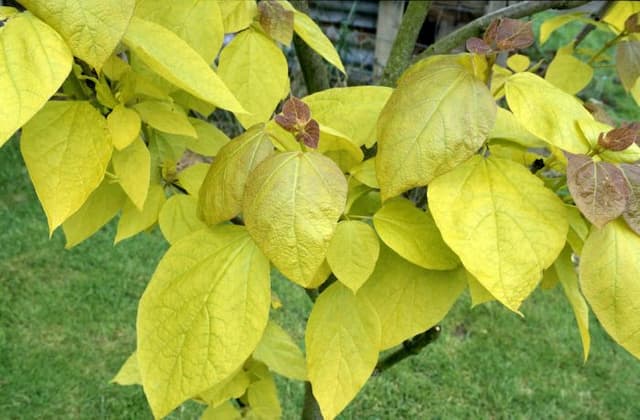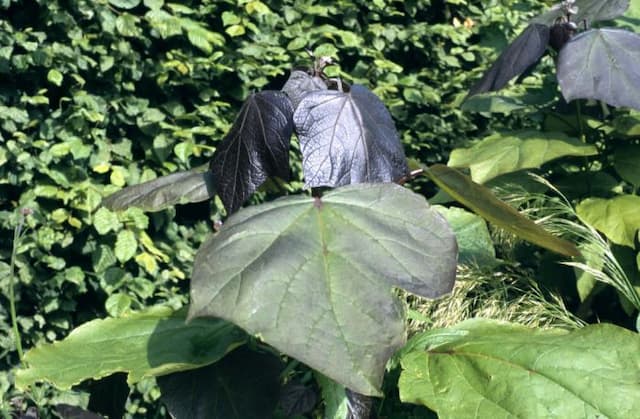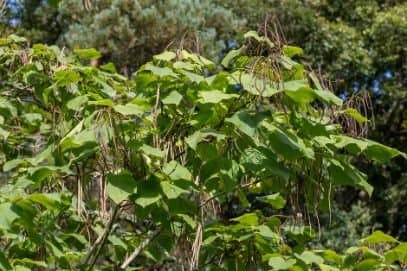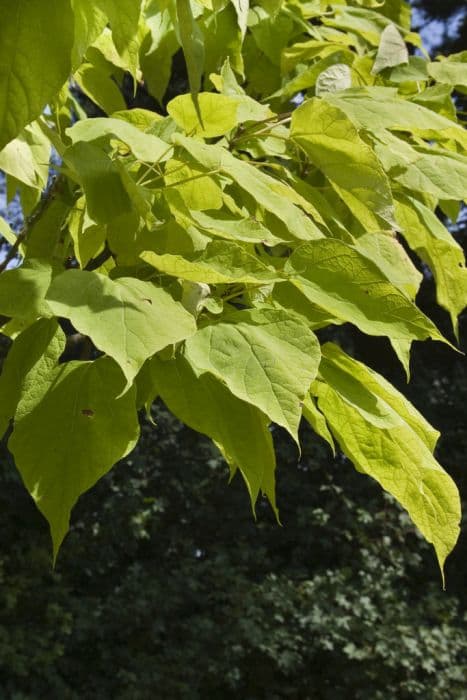Chinese Trumpet Vine Campsis grandiflora

ABOUT
The Campsis grandiflora, commonly known as the Chinese trumpet vine, is a striking plant renowned for its flamboyant floral display. This vigorous climber boasts lush, green foliage which creates a dense, leafy backdrop for its impressive flowers. The leaves are compound, with multiple leaflets arranged in pairs along a central stem, culminating in an odd number at the tip, imparting a feathered appearance. The true spectacle of the Chinese trumpet vine lies in its blooms. The flowers are large, trumpet-shaped, and come in a vivid array of warm hues, primarily shades of red and orange. Each blossom features a flared mouth which opens to reveal a tubular structure, perfect for attracting hummingbirds and other pollinators. These colorful blooms are often found in clusters at the ends of the branches, providing a dramatic visual impact. The plant's flowering season is typically in the warmer months, when the cascades of its radiant flowers can be fully appreciated. The appearance of the Chinese trumpet vine is further enhanced by its fast-growing nature, which allows it to rapidly cover structures such as trellises, walls, or fences. This makes it not only an ornamental beauty but also a practical choice for gardeners looking to create living screens or vertical accents in the landscape. The combination of its lush foliage and spectacular flowers makes the Chinese trumpet vine a visually striking addition to any garden setting.
About this plant
 Names
NamesFamily
Bignoniaceae.
Synonyms
Chinese Trumpet Vine, Grandiflora Trumpet Vine, Chinese Trumpet Creeper.
Common names
Bignonia chinensis, Bignonia grandiflora, Campsis adrepens, Campsis chinensis, Campsis grandiflora var. chinensis, Gelseminum grandiflorum, Tecoma grandiflora.
 Toxicity
ToxicityTo humans
The Chinese trumpet vine is not widely recognized for significant toxicity to humans. However, excessive handling of the plant might occasionally result in skin irritation or an allergic reaction in some individuals. Ingesting large amounts of the plant could potentially cause gastric disturbances, such as nausea or vomiting, but such cases are not commonly reported. If symptoms appear after ingesting any part of the Chinese trumpet vine, it is advisable to seek medical attention.
To pets
The Chinese trumpet vine is not listed as a common toxic plant to pets such as dogs and cats by major animal health organizations like the ASPCA. However, pets may have individual sensitivities or allergic reactions to plants that are generally considered non-toxic. Ingestion of this plant may potentially lead to similar mild gastric disturbances as seen in humans, such as vomiting or diarrhea. If a pet shows adverse signs after consuming any part of the Chinese trumpet vine, it is wise to consult a veterinarian.
 Characteristics
CharacteristicsLife cycle
Perennials
Foliage type
Deciduous
Color of leaves
Green
Flower color
Orange
Height
30 feet (9 meters)
Spread
30 feet (9 meters)
Plant type
Climber
Hardiness zones
7
Native area
Asia
Benefits
 General Benefits
General Benefits- Aesthetic Appeal: Campsis grandiflora, commonly known as Chinese trumpet vine, produces striking large, trumpet-shaped flowers that add vibrant color and aesthetic appeal to gardens and landscapes.
- Attracts Pollinators: The vivid blooms of the Chinese trumpet vine are attractive to bees, butterflies, and hummingbirds, which are essential for pollination and maintaining healthy ecosystems.
- Fast Growing: Chinese trumpet vine is known for its rapid growth, making it ideal for quickly covering trellises, arbors, and fences, thus providing privacy and shade.
- Erosion Control: The plant's dense foliage and sprawling growth habits help stabilize soil and control erosion on slopes and banks.
- Versatility: It can be grown in a wide range of soils and is relatively low-maintenance, making it a versatile choice for gardeners of various experience levels.
- Seasonal Interest: With its vibrant summer blooms and lush green foliage, Chinese trumpet vine adds interest to the landscape across multiple seasons.
 Medical Properties
Medical Properties- Analgesic: Traditionally used to alleviate pain.
- Anti-inflammatory: May reduce inflammation in certain conditions.
- Antioxidant: Contains compounds that are believed to combat oxidative stress.
- Antipyretic: Used to reduce fever.
- Hepatoprotective: Thought to offer some protection to the liver.
- Antibacterial: Has been used to fight certain bacterial infections.
 Air-purifying Qualities
Air-purifying QualitiesThis plant is not specifically known for air purifying qualities.
 Other Uses
Other Uses- Architectural Integration: Chinese trumpet vine can be used to cover and adorn walls, trellises, and fences, adding an aesthetic natural element to buildings and landscape designs.
- Sound Barrier: The dense foliage of the vine can act as a sound barrier, helping to reduce traffic noise when planted along highways or busy streets.
- Shade Provider: When grown over pergolas or arbors, Chinese trumpet vine offers a shaded area underneath, which can be used for outdoor seating or relaxation spots.
- Erosion Control: The plant's root system can help stabilize slopes and banks, preventing soil erosion in vulnerable areas.
- Biofuel Source: While not commonly used for this purpose, the biomass of Chinese trumpet vine has the potential to be used in biofuel production.
- Craft Material: The vines can be harvested and dried for use in basket weaving or as a natural crafting material.
- Habitat Support: Chinese trumpet vine provides nectar for hummingbirds and other pollinators, supporting local biodiversity in gardens and parks.
- Privacy Screening: The vine can be used to create a living screen that offers privacy in urban gardens and terraces.
- Culinary Garnishes: Though not commonly consumed, the vibrant flowers have been used occasionally as an exotic garnish in gourmet cuisine.
- Photography and Art: The attractive blooms and vines can serve as a beautiful subject for photographers and artists, capturing the beauty of nature in their work.
Interesting Facts
 Feng Shui
Feng ShuiThe Chinese Trumpet Vine is not used in Feng Shui practice.
 Zodiac Sign Compitability
Zodiac Sign CompitabilityThe Chinese Trumpet Vine is not used in astrology practice.
 Plant Symbolism
Plant Symbolism- Beauty and Splendor: Campsis grandiflora, commonly known as the Chinese trumpet vine, produces large and stunning flowers, symbolizing natural beauty and magnificence.
- Attraction and Magnetism: Its conspicuous flowers are highly attractive to hummingbirds and humans alike, representing the idea of allure and charm.
- Prosperity and Abundance: The vigorous growth and abundant blossoms of the Chinese trumpet vine are often associated with prosperity and the abundance of life.
- Vibrancy and Energy: The bright orange color of its flowers imparts a sense of vibrancy and energetic life force.
- Entanglement and Connectivity: As a climbing plant, the Chinese trumpet vine's ability to envelope structures symbolizes connections and relationships that are intertwined and complex.
 Water
WaterThe Chinese Trumpet Vine should be watered deeply once a week, providing about 1 to 1.5 gallons depending on the size of the vine and the weather conditions. During hot, dry periods, it may require additional water. Ensure that the soil is moist but not waterlogged. It's crucial to allow the top inch of soil to dry out slightly between waterings to prevent overwatering, which can lead to root rot. Established plants can be more drought tolerant and may need less frequent watering.
 Light
LightThe Chinese Trumpet Vine thrives best in full sun, meaning a spot that receives at least 6 to 8 hours of direct sunlight per day is ideal. It can tolerate partial shade but flowering may be reduced. Ensure the plant is situated in an area where it can receive unfiltered sunlight for the majority of the day for optimal growth and bloom.
 Temperature
TemperatureThe Chinese Trumpet Vine prefers warm climates and grows best in temperatures ranging between 60 to 90 degrees Fahrenheit. It can survive minimum winter temperatures down to around 30 degrees Fahrenheit. To ensure healthy growth, it's best to plant it in a location where the temperature remains within these ranges throughout the growing season.
 Pruning
PruningPruning the Chinese Trumpet Vine is important to maintain its shape, encourage bushier growth, and ensure vigorous flowering. Prune in late winter or early spring before new growth begins. Remove any dead or damaged wood, and cut back the previous year's growth to a few buds. Pruning can be done annually, but the plant can tolerate more frequent pruning if needed to control its size.
 Cleaning
CleaningAs needed
 Soil
SoilThe ideal soil mix for Chinese Trumpet Vine should be well-draining and fertile, with a pH range of 6.0 to 8.0. A blend of garden soil, compost, and perlite or coarse sand can promote good root health.
 Repotting
RepottingChinese Trumpet Vine should be repotted every 2 to 3 years, or when the root system outgrows the current container.
 Humidity & Misting
Humidity & MistingChinese Trumpet Vine thrives best with moderate humidity levels, but it is quite adaptable and can tolerate the varying humidity conditions typically found outdoors.
 Suitable locations
Suitable locationsIndoor
Bright light, well-draining soil, with limited indoor growth.
Outdoor
Full sun, well-draining soil, space to climb, and prune regularly.
Hardiness zone
6-9 USDA.
 Life cycle
Life cycleThe life of Campsis grandiflora, commonly known as the Chinese trumpet vine, begins with germination, where the plant sprouts from seeds typically in the spring, given warm temperatures and moist soil conditions. The seedlings quickly establish a root system and grow into juvenile plants, developing compound leaves and a vigorous stem. As it matures, the trumpet vine enters a vegetative stage, wherein it experiences significant growth both in height and spread, utilizing its developing tendrils to climb on supports. Upon reaching sexual maturity after a few years, the plant produces large, trumpet-shaped flowers in the summer, which are pollinated by hummingbirds and insects, resulting in the formation of elongated seed pods. These seed pods eventually dry and release seeds in late fall to early winter, thereby completing the reproductive cycle. In climates with cold winters, the vine may die back to the ground but will resprout from the roots in the following spring.
 Propogation
PropogationPropogation time
Spring-Early Summer
The Chinese trumpet vine, Campsis grandiflora, is commonly propagated by semi-hardwood cuttings taken during the summer months. To do so, one would select a piece of stem from the current season's growth that has begun to harden or mature but is not yet fully woody. Cut a segment around 4 to 6 inches (approximately 10 to 15 centimeters) long, ensuring it contains several leaf nodes. Remove the leaves from the lower half of the cutting to prevent moisture loss and dip the cut end into a rooting hormone powder to encourage root development. The cutting should then be placed in a potting mixture that is well-draining, keeping the soil moist but not soggy. It is often beneficial to cover the pot with a plastic bag or place it in a propagator to maintain humidity, which aids in the rooting process. Within a few weeks to a couple of months, the cutting should develop roots and can be transferred to a larger pot or to its final growing location.








